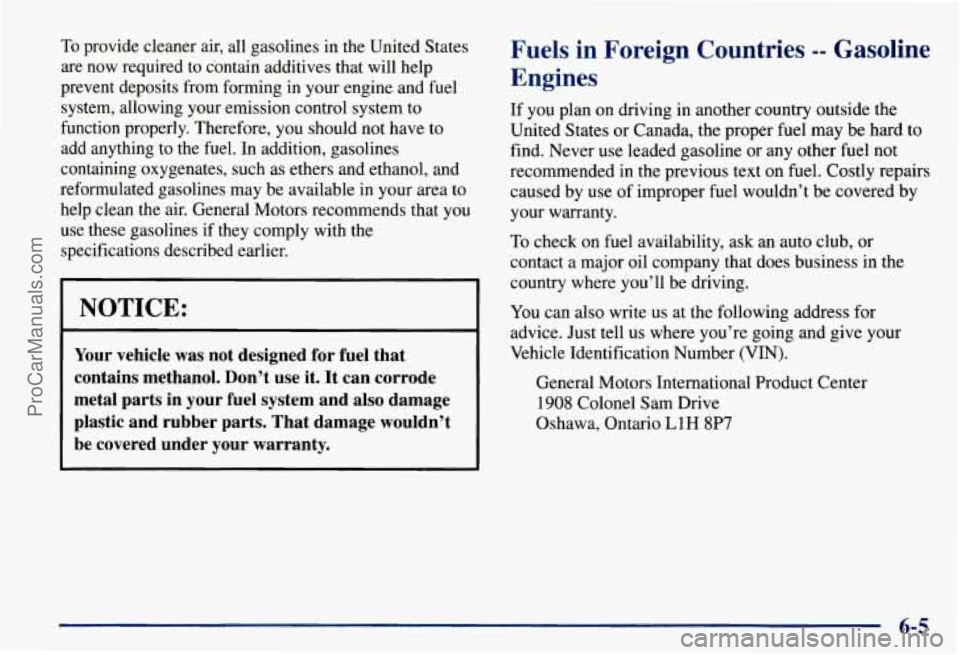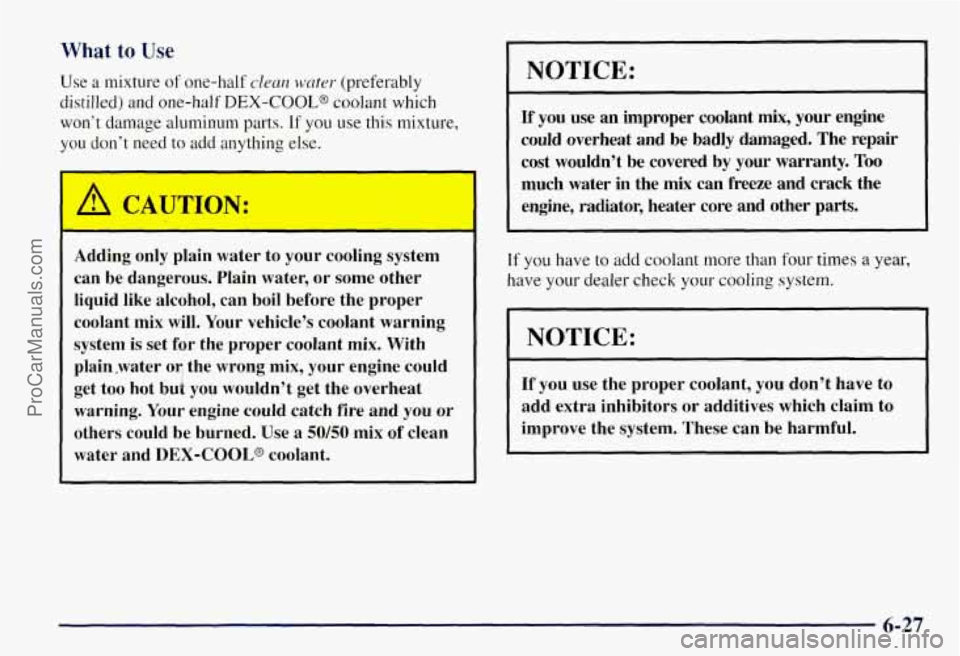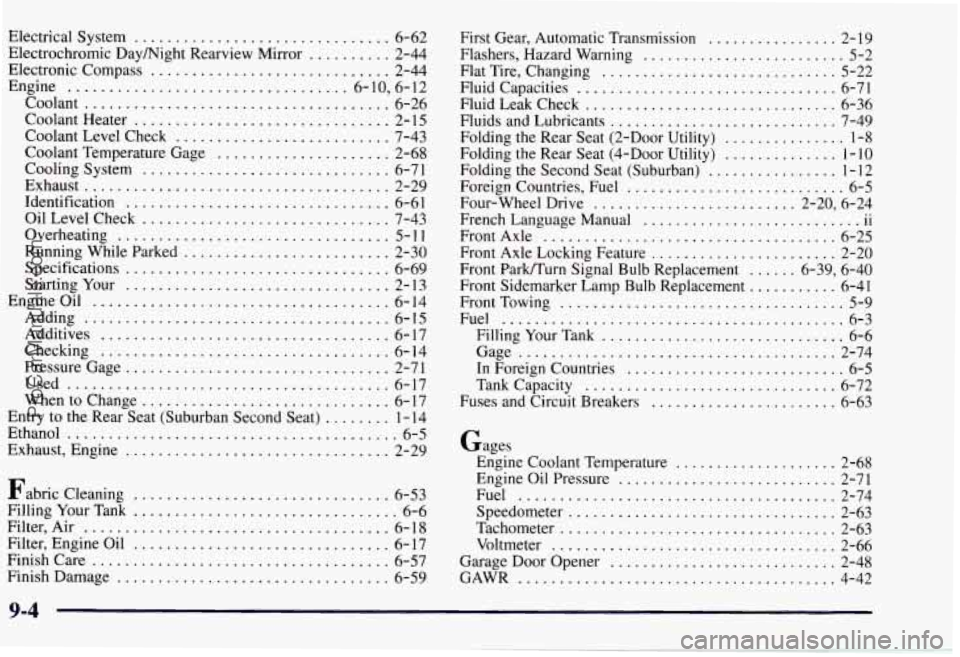oil additives CHEVROLET SUBURBAN 1997 Owners Manual
[x] Cancel search | Manufacturer: CHEVROLET, Model Year: 1997, Model line: SUBURBAN, Model: CHEVROLET SUBURBAN 1997Pages: 433, PDF Size: 21.49 MB
Page 284 of 433

To provide cleaner air, all gasolines in the United States
are now required to contain additives that will help
prevent deposits from forming in your engine and fuel
system, allowing your emission control system to
function properly. Therefore, you should not have
to
add anything to the fuel. In addition, gasolines
containing oxygenates, such as ethers and ethanol, and
reformulated gasolines may be available
in your area to
help clean the air. General Motors recommends that you
use these gasolines
if they comply with the
specifications described earlier.
NOTICE:
Your vehicle was not designed for fuel that
contains methanol. Don’t use it. It can corrode
metal parts in your fuel system and also damage
plastic and rubber parts. That damage wouldn’t
be covered under your warranty.
Fuels in Foreign Countries -- Gasoline
Engines
If you plan on driving in another country outside the
United States or Canada, the proper fuel may
be hard to
find. Never use leaded gasoline or any other fuel not
recommended in the previous text on fuel. Costly repairs
caused by use of improper fuel wouldn’t
be covered by
your warranty.
To check on fuel availability, ask an auto club, or
contact a major oil company that does business in the
country where you’ll be driving.
You can also write us at the following address for
advice. Just tell
us where you’re going and give your
Vehicle Identification Number (VIN).
General Motors International Product Center 1908 Colonel Sam Drive
Oshawa, Ontario
L1H 8P7
6-5
ProCarManuals.com
Page 296 of 433

Engine Oil Additives
Don’t add anything to your oil. Your GM dealer is ready
to advise if you think something should be added.
When to Change Engine Oil
If any one of these is true for you, use the short triplcity
maintenance schedule:
0
0
0
0
0
Most trips are less than 5 to 10 miles (8 to 16 km).
This is particularly important when outside
temperatures are below freezing.
Most trips include extensive idling (such as frequent
driving in stop-and-go traffic).
You operate your vehicle in dusty areas or
off-road frequently.
You frequently tow a trailer or use a carrier on top of
your vehicle.
The vehicle is used for delivery service, police, taxi
or other commercial application.
Driving under these conditions causes engine oil to
break down sooner. If any one of these is true for your
vehicle, then you need to change your oil and filter
every
3,000 miles (5 000 km) or 3 months -- whichever
occurs first. If
none
of them is true, use the long triphighway
maintenance schedule. Change the oil and filter every
7,500 miles (12 500 km) or 12 months -- whichever
occurs first. Driving a vehicle with a fully warmed
engine under highway conditions causes engine oil to
break down slower.
What to Do with Used Oil
Did you know that used engine oil contains certain
elements that may be unhealthy for your skin and could
even cause cancer? Don’t let used oil stay on your skin
for very long. Clean your skin and nails with soap and
water, or a good hand cleaner. Wash or properly throw
away clothing or rags containing used engine oil. (See
the manufacturer’s warnings about the use and disposal
of oil products.)
Used oil can be a real threat to the environment. If you
change your own oil, be sure to drain all free-flowing oil
from the filter before disposal. Don’t ever dispose of
oil
by putting it in the trash, pouring it on the ground,
into sewers, or into streams or bodies
of water. Instead,
recycle it by taking
it to a place that collects used oil. If
you have a problem properly disposing
of your used oil,
ask your dealer, a service station or a local recycling
center for help.
6-17
ProCarManuals.com
Page 306 of 433

What to Use
Use a mixture of one-half clean water (preferably
distilled) and one-half
DEX-COOLS coolant which
won’t damage aluminum parts.
If you use this mixture,
you don’t need to add anything else.
J
A CAUTION:
Adding only plain water to your cooling system
can be dangerous. Plain water, or some other
liquid like alcohol, can boil before the proper
coolant mix will.
Your vehicle’s coolant warning
system is set
for the proper coolant mix. With
plain .water
or the wrong mix, your engine could
get too hot but you wouldn’t get the overheat
warning.
Your engine could catch fire and you or
others could be burned. Use a
50/50 mix of clean
water and
DEX-COOL@ coolant.
I NOTICE:
If’ you use an improper coolant mix, your engine
could overheat and be badly damaged. The repair
cost wouldn’t be covered by your warranty.
Too
much water in the mix can freeze and crack the
engine, radiator, heater core and other parts.
If you have to add coolant more than four times a year,
have
your dealer check your cooling system.
NOTICE:
~~ ~~
If you use the proper coolant, you don’t have to
add extra inhibitors or additives which claim to
improve the system. These can be harmful.
6-27
ProCarManuals.com
Page 425 of 433

Electrical System ............................... 6-62
Electrochromic Daymight Rearview Mirror
.......... 2-44
Electronic Compass
............................. 2-44
Engine
.................................. 6.10. 6.12
Coolant
..................................... 6-26
Coolant Heater
............................... 2-15
Coolant Level Check
.......................... 7-43
Coolant Temperature Gage
..................... 2-68
Cooling System
.............................. 6-71
Exhaust
..................................... 2-29
Identification
................................ 6-61
OilLevelCheck
.............................. 7-43
Overheating
................................. 5-11
Running While Parked
......................... 2-30
Specifications ................................ 6-69
StartingYour
................................ 2-13
Engineoil
.................................... 6-14
Adding
..................................... 6-15
Additives
................................... 6-17
Checking
................................... 6-14
Pressure Gage
................................ 2-71
Used
....................................... 6-17
Whentochange
.............................. 6-17
Entry to the Rear Seat (Suburban Second Seat)
........ 1 - 14
Ethanol
........................................ 6-5
Exhaust, Engine
................................ 2-29
Fabric Cleaning
............................... 6-53
Filling Your Tank
................................ 6-6
Filter, Engine Oil
............................... 6-17
Finish Damage
................................. 6-59
Filter,
Air
..................................... 6-18
Finishcare
.................................... 6-57 First
Gear. Automatic Transmission
................ 2- 19
Flashers. Hazard Warning ......................... 5-2
Flat Tire. Changing
............................. 5-22
Fluid Capacities
................................ 6-71
Fluid Leak Check
............................... 6-36
Fluids and Lubricants
............................ 7-49
Folding the Rear Seat
(2-Door Utility) ............... 1-8
Folding the Rear Seat (+Door Utility) .............. 1-10
Folding the Second Seat (Suburban)
................ 1-12
Foreign Countries. Fuel
........................... 6-5
Four-wheel Drive
......................... 2-20. 6-24
French Language Manual
11
FrontAxle .................................... 6-25
Front Axle Locking Feature
....................... 2-20
Front Park/Turn Signal Bulb Replacement
...... 6-39. 6-40
Front Sidemarker Lamp
Bulb Replacement ........... 6-41
FrontTowing
................................... 5-9
Fuel .......................................... 6-3
Filling Your Tank
.............................. 6-6
Gage
....................................... 2-74
In Foreign Countries
........................... 6-5
Tank Capacity
............................... 6-72
Fuses and Circuit Breakers
....................... 6-63
.. ...........................
Gages
Engine Coolant Temperature
.................... 2-68
Engine Oil Pressure
........................... 2-71
Fuel
....................................... 2-74
Speedometer
................................. 2-63
Tachometer
.................................. 2-63
Voltmeter
................................... 2-66
GAWR
....................................... 4-42
Garage
Door Opener
............................ 2-48
ProCarManuals.com